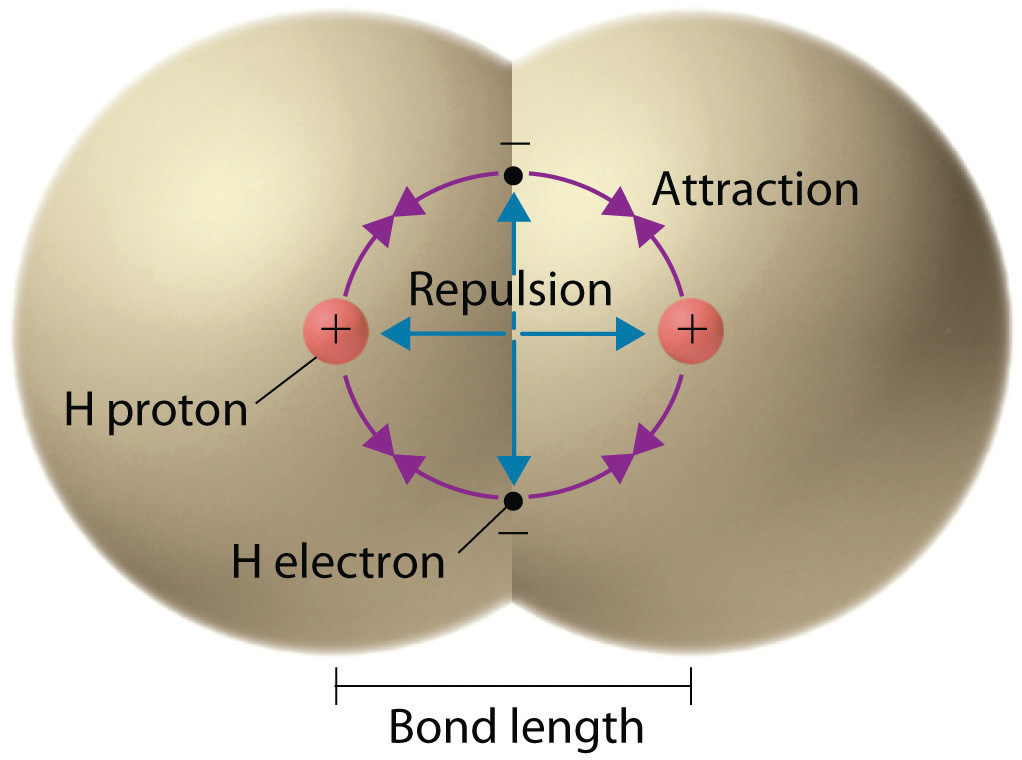
Most of the universe is made up of compounds
The most stable configuration is when energy is released (groud state, lowest energy configuration)
Forming a bond releases energy (exothermic)
Bonds store potential energy
Some atoms form multiple bonds (become more stable, release more energy for each bond formed)
$$ A + B → AB + ΔH $$
In compounds, the nucleus of one atom is attracted to the electron of the other atom (negative force - attraction, negative energy - exothermic)
As radius (distance) between atoms increases, the energy of interaction approaches 0 (very little interaction between the nucleus of one atom and electron of the other atom, use Coulomb’s law)

As radius (distance) between atoms decreases, the energy of the interaction increases (becomes more exothermic)
When atoms come too close together, they start to repel (can’t release any more energy, nuclei are close together and repel more than they are attracted to valence electrons)
Vibrates between repelling and attracting and eventually settles at lowest potential energy state
Reactants (two separate atoms) and products (compounds and energy releases) have equal amounts of energy (law of conservation of energy)
The graph shows that as the nucleus and electron cloud of the other atom overlap more, the potential energy decreases (exothermic), then the frame of reference changes to the repulsion of nuclei (becomes endothermic)
The lowest point on the graph is the most stable (lowest energy conformation possible, balance between attraction and repulsion), number on the y-axis is the enthalpy of the bond
Bond length (distance between the nuclei) depends on the size of the atoms being bonded
Link to simulation for repulsion vs. attraction as two atoms move toward each other
<aside> ⚛️ Typical bonding arrangement of a given atom (does not always have to be used)
</aside>
| NBA for Period 2 | Li | Be | B | C | N | O | F | Ne |
|---|---|---|---|---|---|---|---|---|
| $\Huge{{\cdot \above{0pt} {Li}} \above{0pt} {}}$ | $\Huge{{\cdot \above{0pt} {~Be~\cdot}} \above{0pt} {}}$ | $\Huge{{\cdot \above{0pt} {\cdot~B~\cdot}} \above{0pt} {}}$ | $\Huge{{\cdot \above{0pt} {\cdot~C~\cdot}} \above{0pt} {\cdot}}$ | $\Huge{{\cdot \above{0pt} {\cdot~N\colon}}\above{0pt} {\cdot}}$ | $\Huge{{\cdot \above{0pt} {\colon O\colon}}\above{0pt} {\cdot}}$ | $\Huge{{\cdot\cdot \above{0pt} {\colon F\colon}}\above{0pt} {\cdot}}$ | $\Huge{{\cdot\cdot \above{0pt} {\colon {Ne} \colon}}\above{0pt} {\cdot\cdot}}$ | |
| Number of Valence Electrons | 1 | 2 | 3 | 4 | 5 | 6 | 7 | 8 |
| Number of Bonding Sites | 1 | 2 | 3 | 4 | 3 | 2 | 1 | 0 |